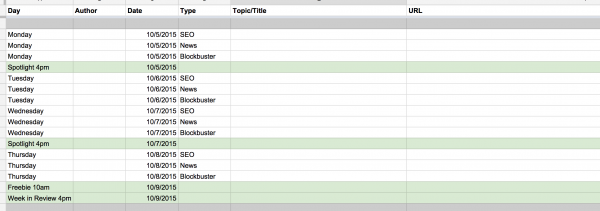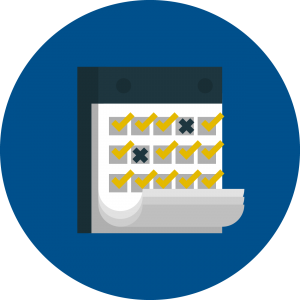
One major benefit niche publishers have, and how to leverage it to create a more effective digital marketing plan for all of your articles.

Have you ever felt like a really great article, or podcast, or email newsletter didn’t perform as well as you thought it would? The thing about a large editorial team is that you may find that pieces of content get lost in the sea of mechanics.
A piece is assigned, created, edited, published and promoted by several different people and there’s no ownership on any one piece, no warm fuzzy feeling when the “publish” button gets pressed.
I think the huge benefit of smaller niche publishing teams is that we have a lot of ownership. The more hats you wear, the more control you have over efficiency and productivity. This can be a good or bad thing, depending on your habit for procrastination (I’ll confess the sins of my former self in a few paragraphs.)
On a small team, one person—usually the online managing editor— may have complete oversight of the whole process of one article. Of course there’s always a second editor in the mix, but it’s not rare for the managing editor of a Mequoda Gold Member system to be the person who writes an article, publishes the email that promotes it, and is the writer of all the social media that goes out surrounding it.
Given our clear advantage of having our arms around the whole process and giving each piece of content a giant bear hug, there also comes the responsibility of keeping the zoo running on time.
Over the years we’ve created a general content production schedule that we use at Mequoda but that any niche publishing managing editor can follow. I find myself sharing it often with other editors I meet at the Mequoda Institute, so it seemed like due time to share it here on the Daily. You can adapt it to your needs and scale it within your own publishing company.
[text_ad]
1. Create a quarterly editorial calendar.
At Mequoda we work at least a quarter ahead on editorial, which allows us to integrate the update of our handbooks on a quarter by quarter basis and include those updates on a week to week basis. At the beginning of each quarter, the entire editorial calendar is planned out, keyword researched, and ready to go (except for our daily news posts).
If you’re a Gold Member, ask your Systems Director to see our template that you can copy and use for yourself. If not, here’s a basic sample of how this calendar might look.
I indicate promotional emails (which we also publish on the blog) in green. Read more about SEO, News and Blockbuster posts included in this calendar, and the email stack that promotes them.

Take-away: It might take a whole day to plan out a quarter, but the time you’ll save thinking up new ideas every week will be worth it.

2. Write two weeks in advance.
There’s nothing worse than working at the last minute. On small teams, this can happen often, where the content you’re writing this morning is the same content you’re publishing this afternoon. Because enough time has passed, I can admit that back in the day when Mequoda was still a baby startup, my day at Mequoda started with getting the current day’s Mequoda Daily out the door. I mean, Mequoda Daily, right? Bless my younger braincells that seemed to fire on all cylinders every morning and allowed this, but that’s just not a way to work, especially if you ever plan to get say, the flu or something.
Thankfully, we’ve reached business maturity and so has our editorial planning. We now have a very streamlined process that is the envy of most of our clients when they first sign on and get the first glimpse of our editorial calendar.
Each week I work with the consultants and our news editor to create a full week of content. I load it into Haven Nexus, schedule it for two weeks out, and send it to our EVP Kim Mateus on a Friday, who reviews everything we publish by the following Friday.
We produce news posts on this same schedule, however our news posts are more about what’s up in the industry and are rarely urgent. When they are, we swap them into a more immediate spot.
Take-away: Give yourself at least a week to write, and your editor a week to review. Better content happens that way.

3. Create emails a week in advance.
Just like the relief I felt when we got two weeks ahead on editorial, there’s nothing like getting a week ahead on emails. If you’re the designated “send” button pusher, you know that scheduling and sending emails is stressful. I’m pretty sure I lose an hour of my life every time I hold my breath and hit “schedule” on an email, praying that even after six hundred email tests to check links, that one won’t come up broken. Based on the conversations I’ve had with other Mequoda managing editors, we’re all in the same boat.
One way to streamline your editorial process and also reduce stress, is by getting a week ahead. After Kim gives me final approval on the posts, I get into email mode and begin coding all the emails for the upcoming week, from Monday through Friday’s Week in Review.
The benefit of working on a small team is that I get control over how it’s promoted in email. If you have a solitary email loader who takes content and loads it into email, they may not be thinking deeply about getting people to click. When you’re the producer of the content, you can take that extra minute to pick the snippet people would be most likely to click on (it’s not always the first paragraph).
At Mequoda, all our emails are themed too. For example, on Tuesdays we write about Digital Magazine publishing. We have three articles in each email. There’s a news post in the middle, but the top and bottom articles we promote are specifically about digital magazines. We figure if someone opens a subject line about digital magazines, then we ought to keep the email themed to what they’re interested in.
Take-away: Scheduling emails in advance will allow you to focus on the rest of your jobs during the week, and reduce your grey hairs to sprouting just one day a week when you schedule instead of every day.
4. Schedule social media a year in advance.
Once emails are ready, we schedule out social media for each post, which sometimes also includes making custom graphics to improve social performance.
You may need to sit down for this one, but Mequoda and most of our clients schedule the social media for every single article out for a full year on Twitter, and six months on Facebook, LinkedIn and G+. I call it the 12x12x12.
For every article we publish, we write 12 unique Tweets. Here are a few ideas:
- The title: Easy, just use the title.
- The title & subhead: Or just the subhead, if it’s too long
- The excerpt: Interesting statement
- The summary: What they’ll learn by clicking the link
- The shout-out: @ anybody mentioned.
- The hashtag(s): Insert extra (related) trending hashtags
- The quote: Find a relevant quote and use it
- The quippy click-bait: Short and sweet
- The friendly suggestion: First-person request to read/share
- The question: Ask a related question
- The engagement: Ask them to comment/give feedback
- The takeaway(s): Subheads and major points
We then schedule these out once per day for 12 days, and then once per month for 12 months. We find that publishing articles to Twitter has a direct effect on how quickly an article gets indexed in search, and that this consistent promotion makes articles rank higher and last longer in those high positions.
The custom graphics are handy for this schedule, so not only are followers seeing us promote the article very differently each time though text, but also visually.
For Facebook/Linkedin/G+, we write two unique social posts, which we schedule for the first day the article publishes, and then for six months later. Haven Share allows us to schedule all of this easily in advance, even before the posts go live.
Take-away: Put in the work now, and your social media feed will be populated every single day with new and recycled content forever. The SEO benefits will be working in the background for a full year on all of your posts.

5. Pay attention always.
One thing we do really well at Mequoda is pay attention. We have a list of 100 blockbuster posts—the posts that send the most amount of organic traffic consistently every month—that we constantly track. 95% of these posts get re-run through this entire process above every 6-12 months. The only time they don’t is if the topic of the post was too newsy to update, or isn’t possible to be updated to our current frame of thinking.
Take-away: Although the first four steps allow you to plan ahead and be the most productive with your time—even allowing you some breathing room—you still need to be hands-on with analytics. Knowing which posts perform best will help keep them on top.
I’m very eager to hear how the schedule looks at your publishing company. Reveal your techniques in the comments!


